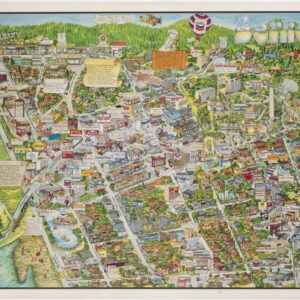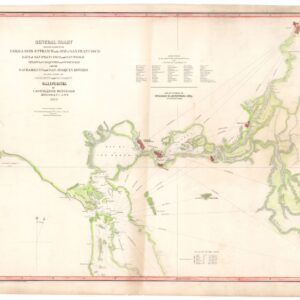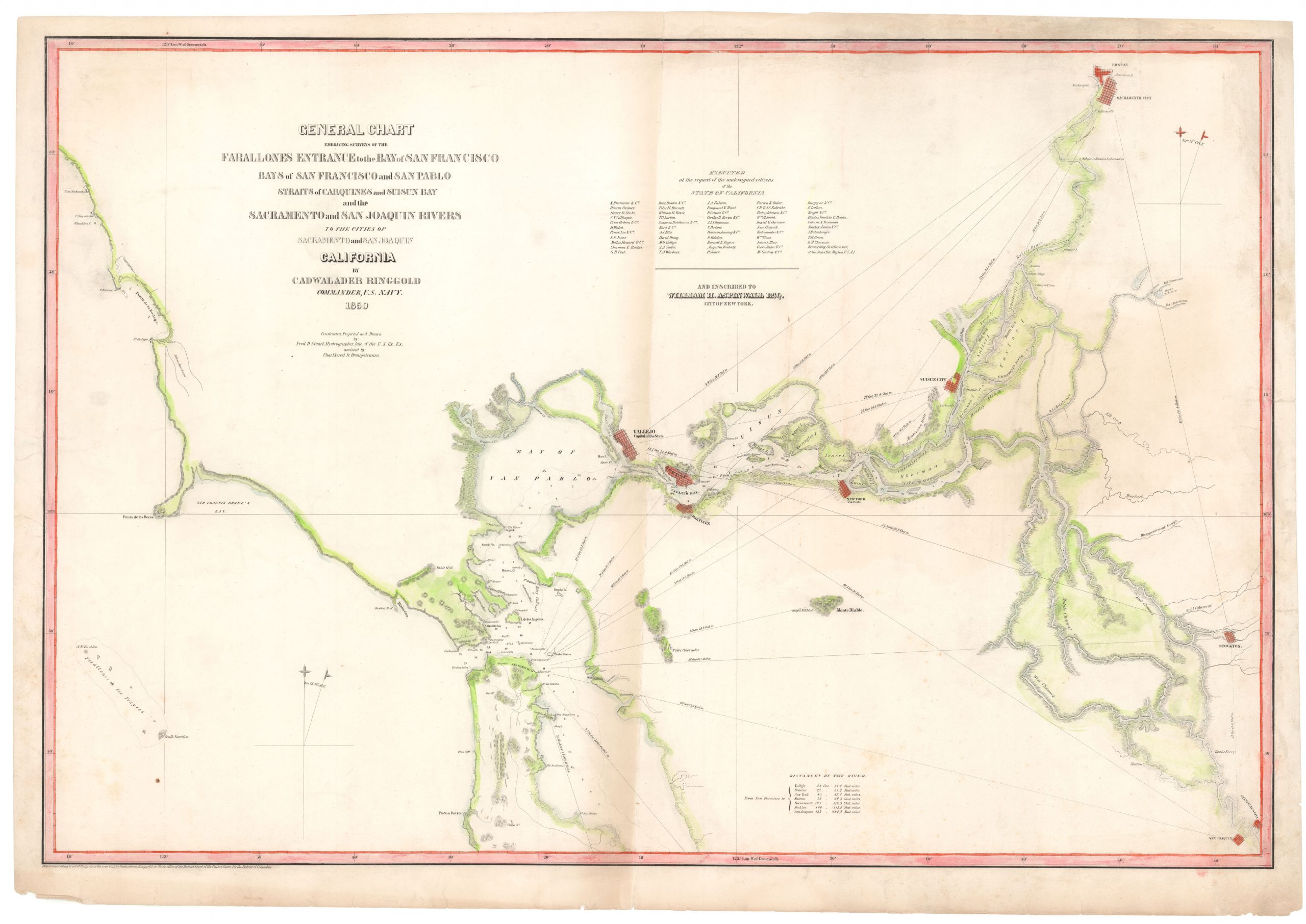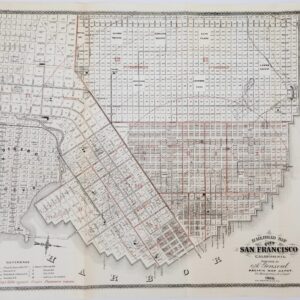Vancouver’s chart of America’s Pacific coastline: the first printed map to identify the Columbia River estuary and Vancouver Island.
Carte de la Partie de la Cote Nord-Ouest de L’Amerique Reconnue pendant Etes de 1792, 1793, et 1794.
$1,200
1 in stock
Description
This exquisitely engraved map of North America’s Pacific coastline – stretching from beyond San Diego in the south to Kodiak Island in the Alaskan north – is a pioneering chart first published in 1799. The mapmaker, George Vancouver, constitutes one of the great naval explorers of the late 18th century, who, along with other great captains like James Cook and Jean Francois La Perouse, was behind the first accurate mapping of this distant part of the globe.
Vancouver was a British Naval officer who conducted several exploratory missions along the west coast of America between 1791 and 1795 and who is perhaps most famous for lending his name to both the island and city of Vancouver. The map depicts the entire coastline in extraordinary detail, including his three expeditionary routes from 1792, 1793, and 1794. When it was published in Paris in 1799, this map was unlike any other of the region published so far. It provided a coherent and reliable chart of almost the entire Pacific coastline of North America, but it did so in the most beautiful and elegant manner possible. George Vancouver’s decisive role in establishing a cartographic foundation for the Northwest Pacific is manifested most clearly in this particular map, making it of outstanding significance and a key piece in any collection focussing on the Pacific Northwest (including California, Oregon, British Columbia, Alaska, and Vancouver itself).
Like many of the most significant maps in history, this is a map of firsts. Despite being issued shortly before the dawn of the 19th century, this was the first printed map to show a whole range of geographic features. Among them was the first mapping of important maritime spaces like Puget Sound, the Johnston Strait, and Cook Inlet in southern Alaska. The latter was of particular importance, as one of Vancouver’s primary goals in the 1793-4 expedition was to unequivocally resolve the existence of a Northwest Passage suggested by earlier missions. At the time, most of the possible routes for a Northwest Passage had been explored and rejected. The only real option that remained was finding an interior route through the lakes and rivers of the Canadian wilderness. One unexplored option for such a route was a large bay named Cook Inlet, which the great explorer had identified and superficially plotted in 1778 but never properly explored. The British Admiralty felt that Cook Inlet was the only viable possibility of an access point to the imagined interior route, and so its thorough exploration was of considerable interest to Vancouver’s patrons. Vancouver complied with his brief and sailed east around Kodiak Island to enter the bay in April of 1794. Over the coming month, he explored every nook and cranny of it, looking for any indications of an inland network of navigable lakes and rivers. But it was to no avail, and by mid-summer, Vancouver turned his expedition around and headed back south.
Another crucial feature of this map was the first detailed rendition of the estuary of the Columbia River. This estuary was vital to British trade interests, as the Columbia constituted a feasible node for trading with the interior and allowed the Brits to tap into a booming trade in American furs. The American adventurer Robert Gray had explored and mapped the lower reaches of the Columbia River the year before, but mapmakers had yet to align his findings with the coastal charts of Cook and La Perouse. Finding the connection between the two was of critical import. Vancouver at first mistook the estuary to be another sheltered bay on the Oregon coast, but once it was confirmed to be the mouth of the river, there could be no doubt that this was a major discovery. In the years following Vancouver’s discovery, the Columbia became the most important riverine connection to the resources of the interior. As if to underline just what a breakthrough the discovery and mapping was, Vancouver’s chart was among those studied very carefully by Lewis and Clark before their great expedition five years later. Sadly, Vancouver would not live to experience this honor.
Despite being of considerably less geographic importance than the Columbia River or Cook Inlet, perhaps the most iconic new element of this map was the confirmation that Vancouver Island was entirely detached from the mainland and subsequently named after its discoverer. A final note should also be made on the inclusion of both an early San Francisco, noted on the map as Port St Francisco, as well as Sir Francis Drake’s supposed 1579 landing point just north of this.
These new features and the overall quality of both the cartography and the engraving made this one of the most exciting maps published in the final year of the 18th century. This was, in many ways, the final frontier, and George Vancouver had ventured where few (if any) Europeans had gone before. That the map was indeed of such extraordinary quality is seen in its longevity. It would take almost four decades before a better chart of the region hit the market. In the years following Vancouver’s expeditions, the Pacific Northwest was opened up to fur traders at every level. For a time, this development exacerbated tensions between the British and a newly independent America, leading eventually to the War of 1812. But it also opened the region up to intrepid trappers and settlers and ushered in the almost mythical era of the Mountain Man.
Bibliographic information
While Vancouver’s original atlas was published in English and issued in 1798, the same year as his death, a much higher quality French version of the atlas appeared the following year. Our gorgeous copy of this sheet comes from this improved French atlas. The French edition saw many of the maps enhanced with new details not present in the original English version, but the new maps were also much higher quality engravings, leading even English collectors to prefer the French edition. While the maps do not list the new engraver, we may assume that these maps were produced under the supervision of Jean-Nicholas Buache de Neuville, who directed the Dépôt des Cartes et Plans de la Marine, where the atlas text informs us the new engravings were produced. Map scholars generally agree that the likely hand behind these exquisite maps was that of Alexandre Blondeau.
Cartographer(s):
George Vancouver (1750-1798) was a British naval officer and explorer most recognized for his three expeditions to the Pacific Northwest. An Englishman by birth, Vancouver joined the Royal Navy as a young man, serving, among other places, as a midshipman on Cook’s ship the HMS Resolution during its second voyage to Australia. He held a similar role during the third Cook expedition, in which the Hawaiian archipelago was discovered, and the illustrious captain was killed. After two solid performances under challenging circumstances, Vancouver was promoted to lieutenant upon their return and trained as a maritime surveyor in the Caribbean. His training included the latest advances in maritime triangulation, which is one of the reasons that Vancouver’s maps achieved such impressive accuracy.
In 1790, The British Admiralty appointed Vancouver as captain of the HMS Discovery and commissioned him to complete the exploration of America’s northwestern coastline that Cook and La Perouse had initiated. This led, among other things, to a decisive mapping of the Pacific coast from San Diego in the south, to Alaska’s Kodiak Island in the north. His map included the identification of Vancouver Island, named after him, and perhaps more importantly of the Columbia River’s estuary, which opened the interior to trade. He also confirmed that Cook Inlet (the bay fronting modern Anchorage) did not constitute an interior Northwest Passage. Having been with Cook to the Sandwich Islands (Hawaii), Vancouver knew to winter there during his four-year expedition, and as a result, he was also the first to produce an accurate map of the Hawaiian archipelago.
Vancouver was a true Enlightenment explorer, more interested in actual discovery than in manifesting politics or religion. Moreover, he had experienced the potential consequences of engaging the unknown with the characteristic British arrogance. He consequently applied an entirely different approach than many of his peers, establishing good relations with many of the indigenous people he came across and exchanging maps and information with several Spanish expeditions despite England’s ongoing conflict with the motherland. In an exchange with the famous Spanish explorer Juan Francisco Bodega y Quadra at Nootka Sound, Vancouver first acquired a copy of Robert Gray’s pioneering chart of the lower Columbia River (1790), which directed him to make his discovery and map of the river’s estuary.
Vancouver’s unusual modus operandi is perhaps one of the reasons that he won several influential enemies among his officers (incl. the famous botanist Archibald Menzies). Vancouver was subjected to slander and degradation following the expedition’s return to England, ultimately dying in obscurity in 1798. His seminal atlas was published the same year in England and reissued in a larger and much better format in French the following year. Despite falling on ill fortune towards the end of his life, Vancouver has since been vindicated as one of the late 18th century’s most noteworthy explorers, and today, he lends his name to many other places than just the city and island of Vancouver.
Condition Description
Minor foxing and wear.
References






![The Original Silicon Valley Map & Calendar [1994]](https://neatlinemaps.com/wp-content/uploads/2021/06/NL-00909_Thumbnail-300x300.jpg)
![The Original Silicon Valley Map & Calendar [1994]](https://neatlinemaps.com/wp-content/uploads/2021/06/NL-00909_Thumbnail.jpg)